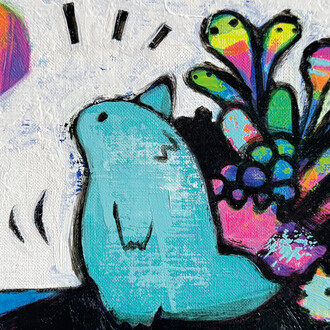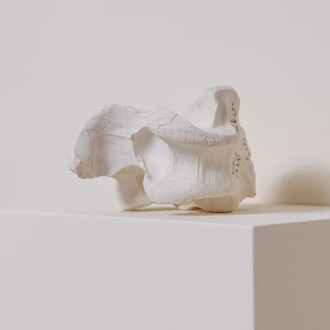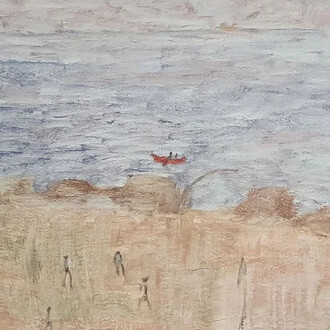Susan Inglett Gallery is pleased to present William Schwedler: Against the grain, an exhibition of paintings and works on paper on view from 3 September to 12 October 2024. An opening reception will be held on Thursday, 5 September 2024, from 6 – 8 PM. William Schwedler (1942-1982) defied categorization throughout his life and a career cut short in the first wave of the AIDS epidemic. Schwedler was too east-coast for the Chicago scene where he cut his teeth, nor in sync with the trends of the New York Pop scene where he made his home. His paintings and works on paper are highly stylized and singular, at times notably challenging the dimensionality of his medium, blurring the line between sculpture and painting.
The first exhibition of these works in New York since the 1980s, Schwedler’s career mirrored the bare locales depicted in his work, occupying a liminal space and rejecting movement, genre, and classification in favor of total artistic freedom. Educated alongside those who would become known as the Chicago Imagists, those who critiqued commerciality and culture via chaotic, graphic compositions, Schwedler opted for a serene, industrial visual language that could be attributed to his upbringing in Chicago, a city of railways, industry, and manufacturing. Works by Schwedler’s classmates and friends from the School of the Art Institute of Chicago, including Cynthia Carlson, Art Green, Gladys Nilsson, Jim Nutt, Christina Ramberg, Karl Wirsum, and Ray Yoshida will be shown in Gallery II.
Architectural influence is felt throughout Schwedler’s oeuvre. Ladders, stairways, trestles, beams, ropes, and other structural accouterments are placed in sparse, surreal environs, jutting into space, disappearing beyond the frame's limits, and serving no apparent purpose. Brick walls, scaffolding, and a recognizable horizon provide the viewer with visual touchstones, and isometric projection, linear perspective, and familiar cardinal directions are done away with in favor of abstracted and illogical spatial reasoning. Axes are disregarded, and in later works, the depth of field is abandoned entirely, with Schwedler’s abstractions occurring on a single plane. Yet, as seen in his shaped-canvas works, the third dimension is ever-present, with elements of the composition, or the substrate itself, protruding into space.
Noticeably void of the direct references to or depictions of the body politic common to the work of his Chicago peers, the New York Pop Art scene, or even his queer contemporaries, Schwedler’s work operated on a subconscious level. Without making bold statements or proclamations, his invented architectures subtly but profoundly affected the viewer’s physical and mental state by altering positionality, sense of scale, distance, and depth. His vertigo-inducing compositions reflect an inner psychological landscape, untethered from the comforts of convention and the familiar, a liminal space and state of being.
William Schwedler (1942-1982) depicts structural and architectural forms in simplistic surroundings while toying with isometry and linear perspective, challenging notions of form, function, and spatial corporeality. An early victim of the HIV/AIDS epidemic, Schwedler’s work exists at the intersection of queer art before, and in the early days of, the crisis.
Schwedler’s work has been shown at Kornblee Gallery, NYC; Alessandra Gallery, NYC; Pyramid Gallery, Washington D.C.; Tibor de Nagy Gallery, NYC; Rosenwald Wolf Gallery, Philadelphia, PA; the Institute of Contemporary Art, Philadelphia, PA; The Whitney Museum, NYC; the Ringling Museum of Art, Sarasota, FL; and more. His work can be found in the collections of the Akron Art Institute, Akron, OH; Art Institute of Chicago, Chicago, IL; Massachusetts College of Art and Design, Boston, MA; the Rhode Island School of Art and Design, Providence, RI; the Whitney Museum of American Art, NYC; the Yale University Art Gallery, New Haven, CT; and more.
















